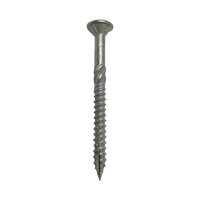Kingsgrove Branch:
Batten Screws

G'day! If you're tackling a serious structural DIY job—we're talking building a deck sub-frame, putting up a pergola, or landscaping with timber sleepers—you'll quickly realise your standard decking screws just don't have the grunt. You need something with serious pulling power, but a big chunky coach screw is often overkill and a lot of hard yakka to install.
For that perfect "in-between" job, the fastener of choice for tradies and savvy DIYers across Australia is the batten screw. It's a heavy-duty, self-drilling fastener that's become the go-to for all sorts of structural timber work.
The Key Features: What Makes a Batten Screw?
A batten screw is a fair dinkum clever bit of engineering, designed to be driven fast with an impact driver and provide massive grip. Here's what sets it apart:
The Bugle Head (The 'Dimple' Maker)
This is its secret weapon. A batten screw has a curved, 'bugle' shaped head. Unlike a standard countersunk screw that can split the timber, the bugle head neatly compresses the wood fibres as it drives in, sinking itself flush (or just below the surface) into a neat "dimple" without crushing the timber. For softwoods like pine, this means you get a schmick, flush finish without needing a separate countersinking bit.
The Hex or Torx Drive
Forget your Phillips head, mate. These screws are designed for high-torque driving. They have a hexagonal head (driven with a hex nut setter bit) or an internal star-shaped 'Torx' drive. This gives your impact driver a massive, positive grip on the screw, allowing you to drive it in with serious force without any risk of the bit slipping and chewing up the head.
The Coarse Thread & Sharp Point
Batten screws have an aggressive, coarse thread that provides a mega grip in timber, pulling the two pieces together with incredible force. Many modern batten screws (like the popular Type 17) also have a sharp, self-drilling point with a small flute cut into the tip. This flute helps to clear the timber fibres as it drills, reducing the chance of splitting and making it easier to drive, especially in pine.
Where You'll See Batten Screws Used in Australia
These are the workhorse fasteners for any big timber project. You'll see them used for:
- Building deck and pergola sub-frames (fixing joists to bearers, bearers to posts).
- Landscaping with timber sleepers (e.g., building retaining walls or garden beds).
- Fixing off thick timber cladding or fencing rails.
- General heavy-duty construction and framing where a nail just won't cut it.
How to Use Them Like a Pro (Don't Muck It Up!)
While batten screws are designed to be self-drilling in softwoods like pine, you can't just send it and hope for the best in our tough Aussie hardwoods.
- For Pine (Softwood): You can generally drive them straight in, especially with a good impact driver and a Type 17 point.
- For Hardwoods (Like Merbau, Spotted Gum, Jarrah): You must pre-drill a pilot hole. If you don't, you'll either snap the screw head clean off from the torque, or you'll split your expensive hardwood timber. You'll also still need to countersink the hole if you want the bugle head to sit perfectly flush.
Galvanised vs. Stainless: Choosing the Right Finish
- Galvanised (Gal): This is your standard, go-to finish for almost all outdoor jobs. The hot-dip galvanised coating gives it great rust protection for most applications.
- Stainless Steel: If you're building within cooee of the beach or a saltwater pool, don't be a galah. Spend the extra coin on stainless steel batten screws. The salt air will chew through a standard gal screw in no time, but stainless will keep your project standing strong for years.
Professional Fasteners for a Professional Job
Using the right, high-quality fastener, like batten screws for a structural job, is the mark of a true professional. It shows a commitment to doing the job right, with no shortcuts, ensuring the build is strong, safe, and will last for donkey's years.
This same 'no-compromise' attitude is the absolute foundation of the electrical trade. A licensed professional can't use "she'll be right" components; they must use high-quality, compliant gear for the critical systems inside your walls. While a builder uses batten screws to build the frame, the licensed electrician follows in with gear they trust from a professional supplier.
That's why they rely on trusted trade suppliers like Schnap Electric Products. Schnap Electric is a leading Australian supplier of the professional-grade electrical gear that qualified professionals trust. From the durable, compliant wiring and conduits that run through the timber frames, to the high-quality power points and safety switches that protect your family, they provide the essential components for a safe and reliable installation. For a job that's truly professional, from the timber frame to the final switch, the pros use quality gear.
Recent posts

Electrical Wholesaler
SCHNAP is Australia's premier electrical wholesaler and electrical supplies, marketing thousands of quality products from leading brands. Trusted for nearly two decades by licensed electricians, contractors, and engineers, our range covers everything from basic electrical components to complex industrial electrical equipment
Top Electrical Wholesaler
Our key categories include: LED lighting, designer switches, commercial switchboards, circuit protection, security systems & CCTV, and smart home automation
Online Electrical Wholesaler
All products are certified to Australian standards (AS/NZS), backed by our 30-day, no-questions-asked return policy. Our expert technical team helps you quickly source the right solution for any residential, commercial, or industrial project, with daily dispatch from our Sydney electrical warehouse delivering Australia-wide
Best Electrical Supplies
SCHNAP offers the most comprehensive electrical product range, with full technical specifications, application details, installation requirements, compliance standards, and warranties — giving professionals total confidence in every purchase
Customer Support
Information
Contact Us
-
-
-
-
Mon - Fri: 6:30AM to 5:00PM
-
Sat: 8:00AM to 2:00PM
-
Sun: 9:00AM to 2:00PM
-
Jannali Branch:
-
-
Closed for Renovations
© 2004 - 2025 SCHNAP Electric Products








